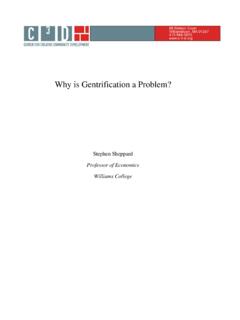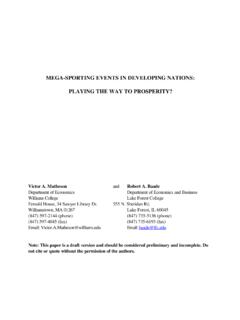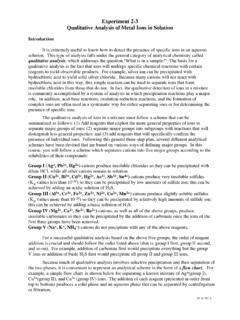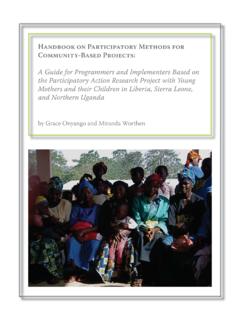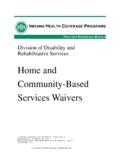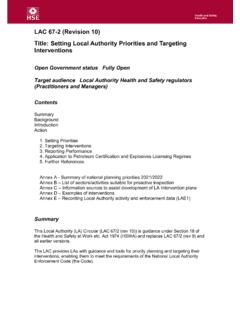Transcription of Community Based Targeting Mechanisms for Social …
1 Community Based Targeting Mechanisms for Social Safety Nets Jonathan Conning Michael Kevane**. December 2000. Abstract This paper interprets case studies and theory on Community involvement in beneficiary selection and benefit delivery for Social safety nets. Several considerations should be carefully balanced in assessing the advantages of using Community groups as Targeting agents. First, benefits from utilizing local information and Social capital may be eroded by costly rent-seeking. Second, the potential improvement in Targeting criteria from incorporating local notions of deprivation must be tempered by the possibility of program capture by local elites, and by the possibility that local preferences are not pro-poor. Third, performance may be undermined by unforeseen strategic Targeting by local communities in response to national funding and evaluation criteria, or by declines in political support. ** Williams College, Department of Economics, Williamstown, MA and Institute for Economic Development, Boston University.
2 Santa Clara University, Department of Economics, Santa Clara, CA 95053. (corresponding author). We would like to extend our appreciation to Harold Alderman, Pranab Bardhan, John Blomquist, Henry Bruton, Michael Cernea, Nora Dudwick, John Giles, Margaret Grosh, William Jack, Emmanuela Galasso, Eric Hanson, Simon Harrigan, Daniel Klein, Alexandre Marc, Jessica Mott, Akbar Noman, Albert Park, Tamara Perkins, Jean-Philippe Platteau, Ashok Rai, Vivajendra Rao, Gustav Ranis, Martin Ravallion, Mary E. Schmidt, Endre Stiansen, William Sundstrom, Michael Woolcock and participants at workshops at the World Bank and at FUNDP Namur for providing input, suggestions and material. Nishant Nayyer provided able research assistance. INTRODUCTION. Social safety nets can serve an important role in alleviating poverty and in promoting long- term growth by providing households with the protection that markets and informal networks may not supply.
3 A Social safety net may redistribute resources toward disadvantaged groups, or sustain political coalitions to support critical structural reforms. Unfortunately, the growing awareness of the importance Social safety nets in developing countries has not been translated into effective action because of the failure of traditional Social welfare ministries to effectively reach and engage the poor. This has led to experimentation with new bottom-up service delivery options and poverty alleviation Mechanisms that more actively involve the poor and their communities in program design, implementation and monitoring. Examples include reforms that decentralize the delivery of public services to local governments, Community management of forests and other natural resources, and group- Based microcredit programs. Demand-driven Social funds that aim by design to elicit Community involvement have become increasingly popular with governments and donors, and international organizations such as the World Bank now make Community participation an explicit criterion for funding approval for a growing list of projects (World Bank 1996, World Food Program 1998).
4 Common sense and substantial evidence suggest that Community participation can lead to improved project performance and better Targeting (Baland and Platteau (1996), La Ferrara (1999), Narayan et al. (1997), Wade (1988), Isham et al. (1995)). For example, a study of India's Integrated Rural Development Project found that Indian states which employed village councils to select beneficiaries had a much smaller proportion of non-poor participating households (Copesake 1992). A large recent survey of dozens of country experiences with Social safety nets Community Based Targeting FOR Social SAFETY NETS. conducted by Subbarao et al. (1997, p. 87) for the World Bank contends that programs that involve communities, local groups, and NGOs can achieve better Targeting outcomes. The purpose of this paper is to review evidence and to propose a framework for thinking about the Community - Based Targeting Mechanisms to deliver private benefits, Mechanisms that target welfare or For the purposes of this review, we define Community - Based Targeting as a state policy of contracting with Community groups or intermediary agents to have them carry out one or more of the following activities: 1) identify recipients for cash or in-kind benefits, 2) monitor the delivery of those benefits, and/or 3) engage in some part of the delivery process.
5 Community agents can be Social or religious groups, single-purpose NGOs, or local elected officials or governing bodies. The extent to which an agent qualifies or not as a Community agent depends on that agent's level of embeddedness in local Community affairs. By this we mean the degree of involvement of the group or functionary in other functions and activities that imbricate that agent in poor sub-communities, or the degree of involvement in day-to-day Community life of the poor(through residence, leisure, private business). Throughout the paper we will often treat Community groups and intermediary agents as coterminous, and apply the single label Community agents'. Several advantages might be expected from Community - Based Targeting . There may be lower costs of administration through better cost sharing and faster setup where other 1. Many useful lessons can be drawn from existing studies of Community participation in programs where project benefits are shared such as Social funds, the decentralized provision of local public goods (Narayan and Ebbe 1997, Reddy 1998), or Community management of natural resources (Agrawal and Gibson 1999, Baland and Platteau 1996, Leach, Mearns and Scoones 1999).
6 However, the program design and political considerations that arise in Targeting private benefits are sufficiently distinct as to merit their own separate review. Harnessing Community participation to manage a common forest area, to deliver a local public good such as a health clinic, or to maintain a collective reputation vis- -vis a micro-credit program, are all activities where the participants are at the same time beneficiaries and intermediaries. When delivering cash or in kind benefits however, the intermediary and the beneficiary are typically no longer the same (and indeed may have quite different interests) and so a different set 2. Community Based Targeting FOR Social SAFETY NETS. administrative structures are weak or non-existent. Involving Community groups as stakeholders may lead to better screening, monitoring and accountability. Community groups may have better information for identification of needs, and households may in turn have less incentive or opportunity to provide false information on assets, income or shocks.
7 Local definitions of deprivation may be more adaptable to local conditions and culture than rigid technical national formulas. Programs may not only harness but may potentially also strengthen Social capital and Community organizations, with positive external effects. This may be especially true for the disadvantaged groups who may be empowered in by becoming better able to articulate and press demands. Community mobilization may be an end in itself, but may also confer legitimacy to programs that in turn helps build political support for targeted approaches. Despite these advantages, there are several reasons to question the practicality or wisdom of Community - Based Targeting in some settings. Amongst other problems, Community - Based Targeting may lead to, or increase conflict and divisions within the Community ; it may impose high opportunity costs on Community leaders, it may be subverted to serve elite interests, and like any other decentralized welfare program, it may fail to take account of important externalities across communities (such as differential benefits leading to population movements).
8 Or could undermine political support for targeted approaches. This paper, an interpretative review of the literature, will explore just how well communities might use local information and Social capital to allocate new program resources toward the poor and vulnerable. We first briefly present several examples of Community - Based Targeting schemes. We follow this with an outline of many of the most important effects and options in constructing a Community - Based Targeting scheme. The remaining three sections focus on what of incentives must be provided. 3. Community Based Targeting FOR Social SAFETY NETS. appear to be the major tradeoffs in the public policy choice of Community - Based Targeting . First, will Community - Based Targeting 'increase the size of the cake'? In other words, will Community Mechanisms be effective at lowering the costs of delivering benefits to a target population? Second, what size slice of cake will the poor obtain?
9 That is, what kinds of distributions are likely to emerge when Community - Based Targeting is employed after taking into account the need to provide incentives, program leakage, and the rents that intermediary agents could potentially capture? Also, under devolution local Targeting preferences, determined through local political processes, might differ substantially from national preferences or those of a donor. Finally, what will determine the cake-making ingredients' available to Community - Based agents for disbursal to eligible recipients? Here we focus on the national-level political economy and program design issues that arise while implementing a decentralized policy of Community - Based Targeting . We conclude with some observations about how to design a Community - Based Targeting scheme. Current experiments have tended to use homogeneous Community agents across the country to implement Targeting for example, local town mayors in every poor Community .
10 But agents that would empower the poor and be responsive to poor constituencies are unlikely to be homogeneous across countries, and so a more demand-driven approach to Community - Based Targeting may be recommended in some cases. We also believe that in many instances the best Community - Based Targeting schemes will be hybrid Mechanisms where the center defines and monitors Targeting categories, rather than unconditional devolution to Community groups with little basis for evaluation or control. 4. Community Based Targeting FOR Social SAFETY NETS. Examples of Community - Based Targeting There are several modern and historical examples of purposeful large-scale Community Based Targeting for Social safety Arguably one of the earliest and most studied examples of a Community - Based Targeting mechanism was the English system of poor relief. For several hundred years until the reforms of 1834, the English poor laws implemented a highly decentralized system of poor relief administered and financed by local parishes.
